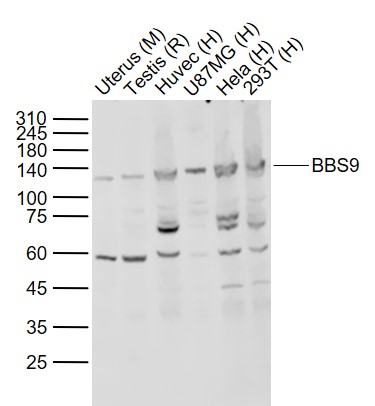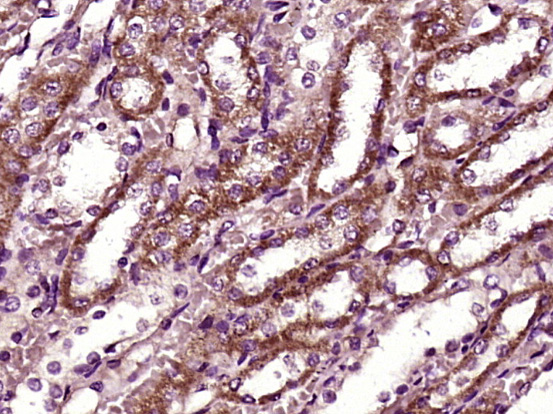
Rabbit Anti-BBS9 antibody
B1 antibody; Bardet Biedl syndrome 9; Bardet-Biedl syndrome 9 protein; bbs9; C18 antibody D1 antibody MGC118917; 1 gene protein; Protein PTHB1; PTH-responsive osteosarcoma B1 protein; PTHB1; PTHB1_HUMAN.
View History [Clear]
Details
Product Name BBS9 Chinese Name 巴尔得-别德尔综合征相关蛋白9抗体 Alias B1 antibody; Bardet Biedl syndrome 9; Bardet-Biedl syndrome 9 protein; bbs9; C18 antibody D1 antibody MGC118917; 1 gene protein; Protein PTHB1; PTH-responsive osteosarcoma B1 protein; PTHB1; PTHB1_HUMAN. Research Area Tumour Neurobiology Signal transduction Growth factors and hormones Endocrinopathy Immunogen Species Rabbit Clonality Polyclonal React Species Human, Mouse, Rat, (predicted: Dog, Pig, Horse, Rabbit, Sheep, ) Applications WB=1:500-2000 ELISA=1:5000-10000 IHC-P=1:100-500 IHC-F=1:100-500 ICC=1:100-500 IF=1:100-500 (Paraffin sections need antigen repair)
not yet tested in other applications.
optimal dilutions/concentrations should be determined by the end user.Theoretical molecular weight 99kDa Cellular localization cytoplasmic The cell membrane Form Liquid Concentration 1mg/ml immunogen KLH conjugated synthetic peptide derived from human BBS9: 244-320/887 Lsotype IgG Purification affinity purified by Protein A Buffer Solution 0.01M TBS(pH7.4) with 1% BSA, 0.03% Proclin300 and 50% Glycerol. Storage Shipped at 4℃. Store at -20 °C for one year. Avoid repeated freeze/thaw cycles. Attention This product as supplied is intended for research use only, not for use in human, therapeutic or diagnostic applications. PubMed PubMed Product Detail BBS9 is an 887 amino acid protein that localizes to both the cytoplasm and the centrosome and exists as six alternatively spliced isoforms. Expressed in a wide variety of tissues, including liver, lung, heart, brain and skeletal muscle, BBS9 functions as a component of the multi-protein BBSome complex which is required for ciliogenesis and is regulated by GDP/GTP exchange factors. Defects in the gene encoding BBS9 are associated with the pathogenesis of Bardet-Biedl syndrome type 9 (BBS9), an autosomal recessive disorder that is characterized by severe pigmentary retinopathy, early onset obesity, polydactyly, hypogenitalism, renal malformation and mental retardation. Additionally, chromosomal aberrations involving the BBS9 gene may play a role in the formation of Wilms tumor 5 (WT5).
Function:
The BBSome complex is required for ciliogenesis but is dispensable for centriolar satellite function. This ciliogenic function is mediated in part by the Rab8 GDP/GTP exchange factor, which localizes to the basal body and contacts the BBSome. Rab8(GTP) enters the primary cilium and promotes extension of the ciliary membrane. Firstly the BBSome associates with the ciliary membrane and binds to RAB3IP/Rabin8, the guanosyl exchange factor (GEF) for Rab8 and then the Rab8-GTP localizes to the cilium and promotes docking and fusion of carrier vesicles to the base of the ciliary membrane.
Subunit:
Part of BBSome complex, that contains BBS1, BBS2, BBS4, BBS5, BBS7, BBS8, BBS9 and BBIP10. The BBSome complex binds to PCM1 and tubulin.
Subcellular Location:
Cytoplasm, cytoskeleton, centrosome. Cell projection, cilium membrane. Cytoplasm. Note=Localizes to nonmembranous centriolar satellites in the cytoplasm.
Tissue Specificity:
Widely expressed. Expressed in adult heart, skeletal muscle, lung, liver, kidney, placenta and brain, and in fetal kidney, lung, liver and brain.
DISEASE:
Defects in BBS9 are a cause of Bardet-Biedl syndrome type 9 (BBS9) [MIM:209900]. Bardet-Biedl syndrome (BBS) is a genetically heterogeneous, autosomal recessive disorder characterized by usually severe pigmentary retinopathy, early onset obesity, polydactyly, hypogenitalism, renal malformation and mental retardation.
SWISS:
Q3SYG4
Gene ID:
27241
Database links:Entrez Gene: 27241 Human
Entrez Gene: 319845 Mouse
Omim: 607968 Human
SwissProt: Q3SYG4 Human
SwissProt: Q811G0 Mouse
Unigene: 372360 Human
Unigene: 176725 Mouse
Unigene: 92828 Rat
Product Picture
Lane 1: Uterus (Mouse) Lysate at 40 ug
Lane 2: Testis (Rat) Lysate at 40 ug
Lane 3: Huvec (Human) Lysate at 30 ug
Lane 4: U87MG (Human) Lysate at 30 ug
Lane 5: Hela (Human) Lysate at 30 ug
Lane 6: 293T (Human) Lysate at 30 ug
Primary: Anti-BBS9 (SL11511R) at 1/1000 dilution
Secondary: IRDye800CW Goat Anti-Rabbit IgG at 1/20000 dilution
Predicted band size: 100-110 kD
Observed band size: 120 kD
Paraformaldehyde-fixed, paraffin embedded (Rat kidney); Antigen retrieval by boiling in sodium citrate buffer (pH6.0) for 15min; Block endogenous peroxidase by 3% hydrogen peroxide for 20 minutes; Blocking buffer (normal goat serum) at 37°C for 30min; Antibody incubation with (BBS9) Polyclonal Antibody, Unconjugated (SL11511R) at 1:400 overnight at 4°C, followed by operating according to SP Kit(Rabbit) (sp-0023) instructionsand DAB staining.
Bought notes(bought amounts latest0)
No one bought this product
User Comment(Total0User Comment Num)
- No comment




 +86 571 56623320
+86 571 56623320
 +86 18668110335
+86 18668110335

